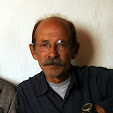I watch transfixed. Pir Zêdo suddenly drops the egg to the concrete; its yoke is deep orange. With no fanfare, it is over. The man gives Pir Zêdo's wife some money and he leaves. “He will wake up tomorrow and the yellowness in his face will be gone,” Pir Zêdo tells me. Although the young man is not insane, the faith for the cure of his jaundiced face and fatigue is as complete.
I am in the town of Ba'adre in (Iraqi) Kurdistan visiting perhaps my best friend among the Yezidis, Amer Sedo. It is the town of the Yezidian Prince's family, although the current prince, Tahseen Beg, has long since moved to the town of 'Eyn Sifni to the southeast. Ba'adre is one of a string of Yezidian towns and villages that border the eastern edge of the Mesopotamian Plains, most hugging the gentle foothills of the increasingly rugged Zagros Mountains.
We are taking a leisurely afternoon walk below Amer's home built on the hill overlooking the town. It abuts a teetering high stonewall, all that remains of Palace of the Prince. After photographing the nishangah (shrine) of Sultan Eyzi, we wander on.
 |
| Remains of the Prince's Palace |
 |
| nishangah Sultan Eyzi |
This is the Mazar Hajial. This is where the insane come to be cured. All are welcome, regardless of faith or ethnicity.
We open the door into the adjacent courtyard and are greeted by Pir Zêdo, a gentle man of soft features, beard, and voice.
 |
| Pir Zêdo and Wife |
The mazar, renovated in 2007, has been here for “more than 1,000 years,” and the mejawar (keeper) has always been from Pir Zêdo's family. She brings a picture of his father from the house: Pir Ali, stooped with his hoop-handled cane and long white beard is a vision out of Victorian travels.
 |
| Pir Zêdo's father, Pir Ali |
The day the afflicted is treated, a sheep is killed, and the “madman” is taken inside the mazar. Pir Zêdo ties his hands and feet, softly “beats” the man saying the prayers all the while, lights the candles in the inner chamber, and leaves the afflicted to pass the night alone inside. In the morning, the insanity is gone. Done. Infallible.
“When was the last time you cured someone?” “Five months ago."
Pir Zêdo gently shakes my hand as we leave.
 |
| Pir Zêdo in front of Mazar Hajial |






Great read thankyyou
ReplyDelete